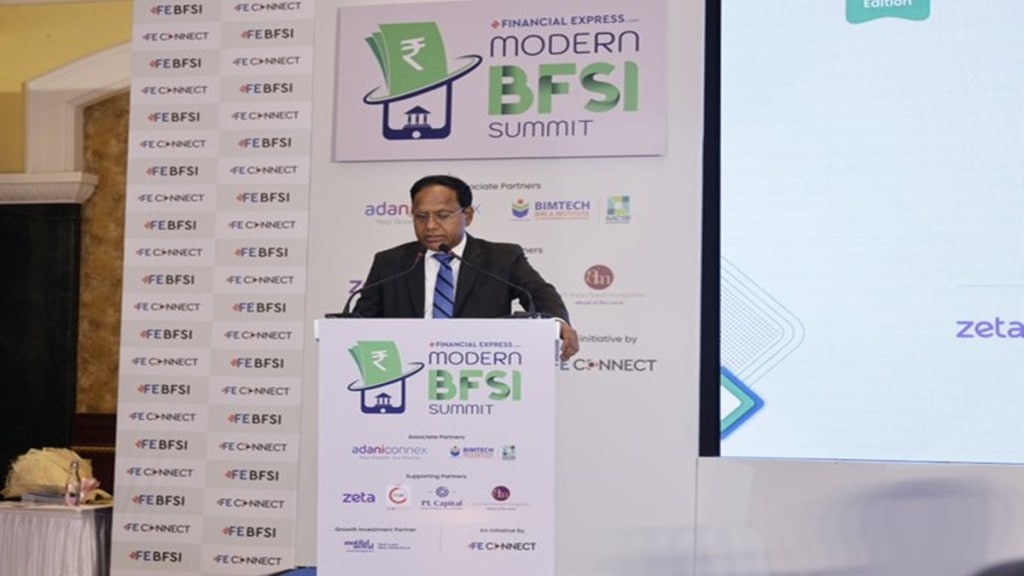Banks need to further step up lending to meet the economy’s demanding growth requirements, and should not hesitate to explore multiple avenues to raise the capital needed, financial services secretary M Nagaraju said on Friday. He assured all necessary policy support to the lenders, and hinted at relaxations in the foreign direct investment (FDI) rules.
Speaking to Financial Express Deputy Managing Editor Shobhana Subramanian at the FE Modern BFSI Summit here, Nagaraju said: “We also actually need to look at reviewing the current FDI rules in the banking sector to enable Indian banks to raise more capital…more patient capital.”
The FDI in private banks is currently capped at 74%, whereas the limit is 20% for public sector banks (PSBs); any single entity cannot hold more than 15% in any Indian bank unless exemption is granted by the Reserve Bank of India (RBI).
“If foreign capital comes at a cheaper rate, I think we should welcome (it). Currently, it is 15% (single entity cap), and if it can be more, the banks will be able to expand credit, that’s the goal,” the DFS secretary said.
Focus on Credit Expansion and MSMEs
He stressed the need to have sustained high growth in credit flows to the needy sectors of the economy, including MSMEs. As of June 27, 2025, credit offtake was up 9.5% on year, lagging deposit growth of 10.1%.
Nagaraju’s comments come at a time when State Bank of India (SBI) has raised Rs 25,000 crore through qualified institutional placements (QIPs) to bolster its capital base, and other state-run banks among themselves are set to raise Rs 20,000 crore via this route in the current financial year.
“Credit growth is a little slower in this quarter, but we are expecting that it will pick up…we also want the banks to lend,” the official said. With large corporations flush with cash, credit growth is now largely directed at MSMEs, the secretary said.
Capital, consolidation and global ambition
In March 2025, the aggregate capital adequacy ratio (CAR) of 46 major banks reached a record high of 17.2%, but the credit flows haven’t been exactly keeping pace with this, or the investment demand to the assisted via bank capital.
With banks required to play a pivotal role in driving India’s ambition of becoming a $30-trillion economy by 2047, he said bank credit to the private non-financial sector should reach around 130% of the gross domestic product (GDP) from 56% now.
According to Nagaraju, banks and financial institutions need to explore and expand various avenues of raising capital, including conventional equity markets, issuance of Basel III-compliant AT1 bonds and tier 2 instruments. They could also explore innovative methods like tapping global financial hubs, green bonds, sustainability-linked loans and also foreign debt markets to fund domestic credit expansion. He also urged large incumbent banks to focus on capital conservation by reducing operational costs with the use of technology.
Nagaraju said banks ought to reimagine deposit mobilisation and increase leverage and productivity, deepen digital and data capabilities, and build future-readiness in terms of ESG-resilience and governance. By advancing these strategic themes, Indian banks could actually transform themselves into stronger institutions, he said.
“Therefore, access to capital from all sources needs to be looked at and worked upon by all of us. We need multiple globally competitive large banks facilitating access to global funds, best talent and technical expertise,” he said. Currently, only two Indian banks –SBI and HDFC– are in the top 100 global banks by total assets, which is not enough, he said, drawing comparison to lenders in China and the US.
On further consolidation of PSBs, he said the previous mergers have yielded good results. “We would see that wherever the synergies are, we can always look at them (more PSB mergers).”
Banks anchor inclusive growth by bringing the unbanked under formal financial systems, enabling millions through schemes like Pradhan Mantri Jan Dhan Yojana, Pradhan Mantri Jeevan Jyoti Bima Yojana, Pradhan Mantri Suraksha Bima Yojana, and more, he added.

